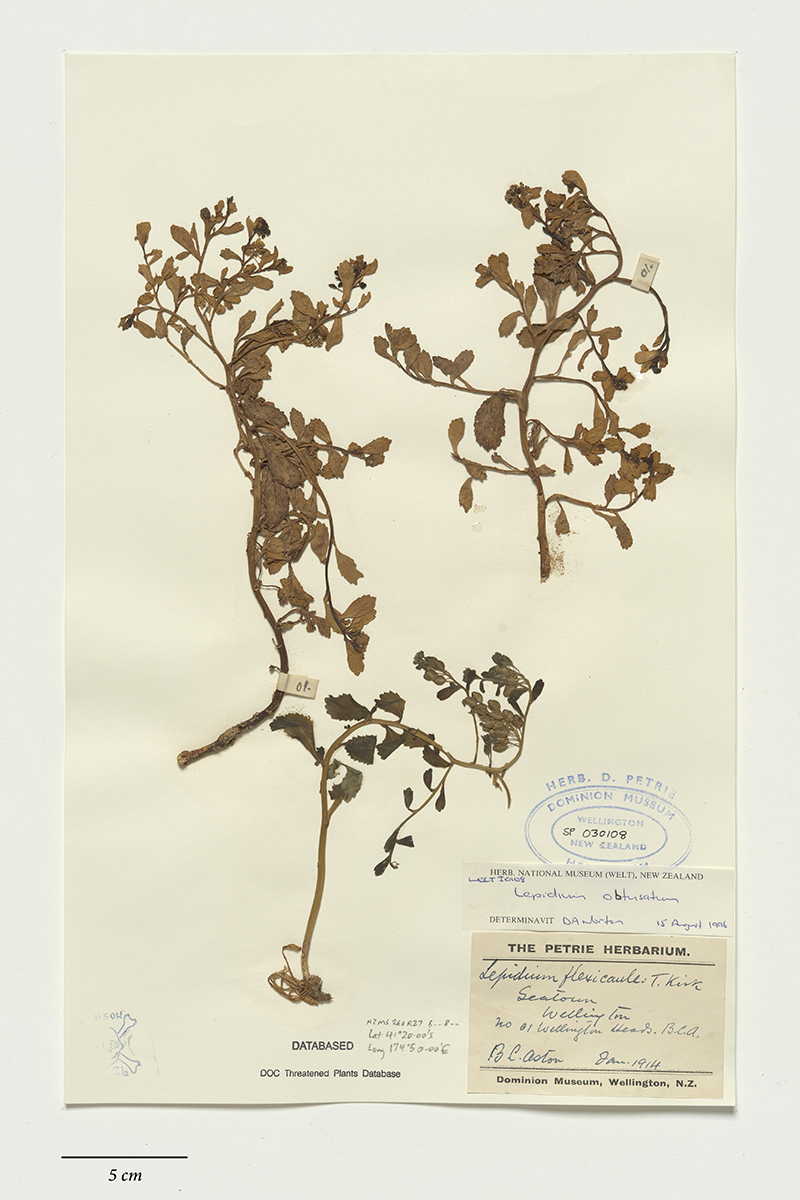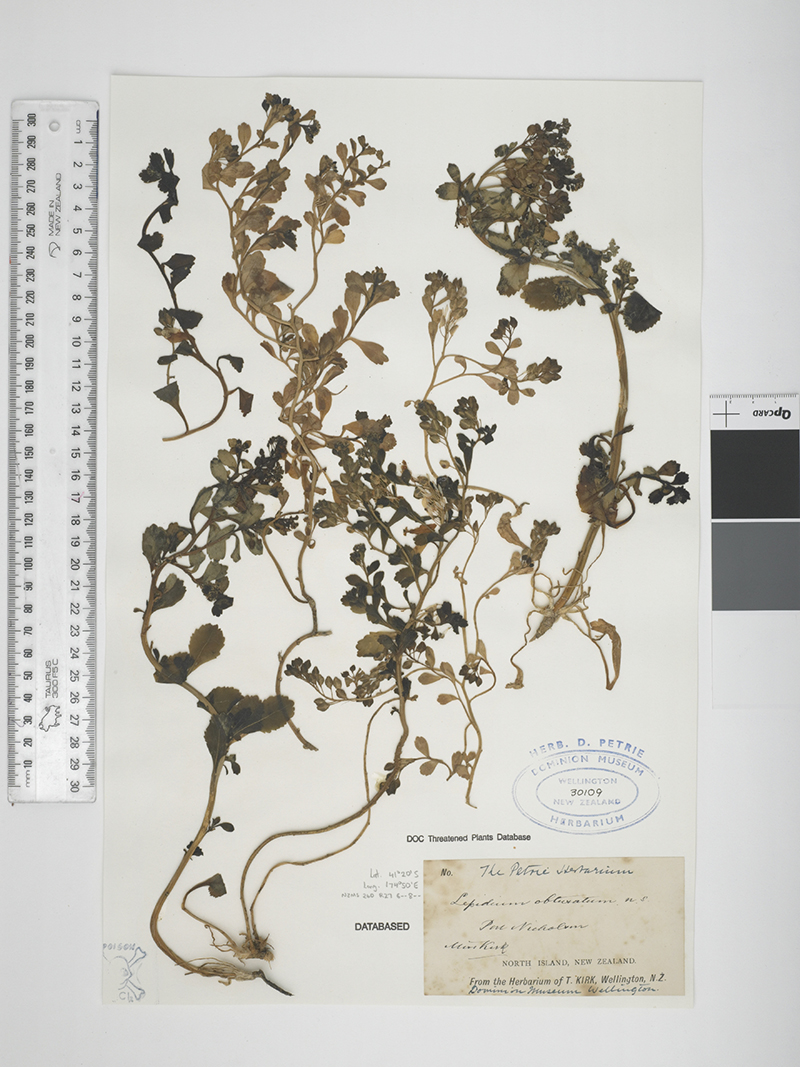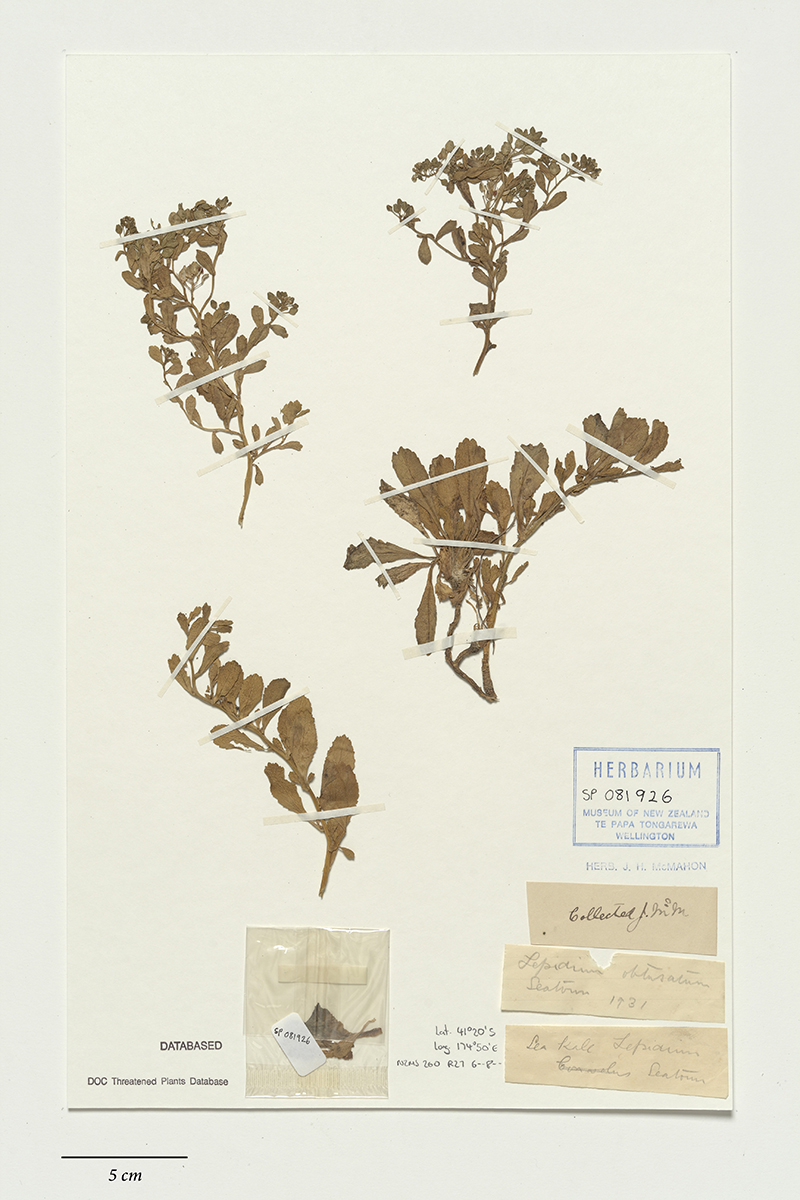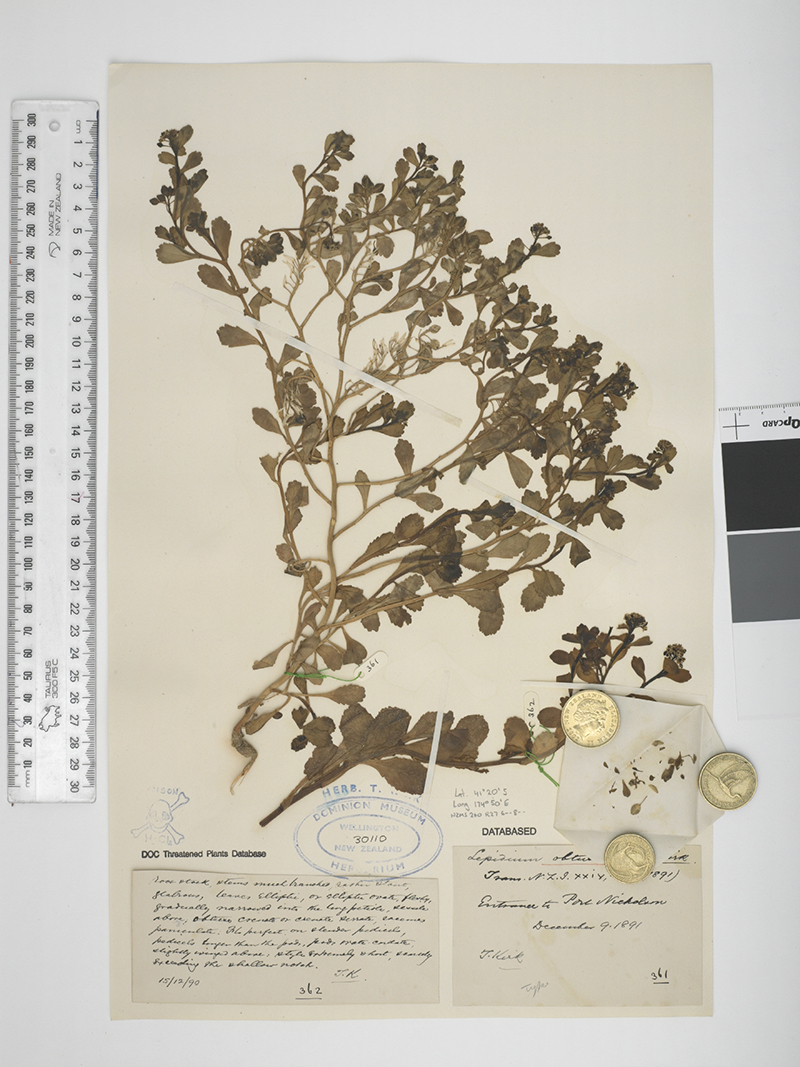Lepidium obtusatum Kirk (1892 "1891":423)
Taxonomy & Nomenclature
Synonym/s: Lepidium loulanicum C.H.An & G.L.Zhou in Fl. Xinjiangensis 2(1): 374 (1995)
Conservation Status
Extinct (Wilson & Given, 1989 fide Norton, 1991:52; WCMC, 1992:218; de Lange et al., 2013:11; de Lange, 2014; Humphreys et al., 2019; Abeli et al., 2022b; Albani Rocchetti et al., 2022; POWO, 2024; Christenhusz & Govaerts, 2025)
Last record: 1950 (Christenhusz & Govaerts, 2025); 1950 (wild) (de Lange, 2014); 1951 (de Lange et al., 2013)
IUCN RedList status: Extinct
This species has been identified as one of the 50 best candidates for de-extinction, ranking 46/50 (Albani Rocchetti et al., 2022).
Distribution & Habitat
North Island, New Zealand
Biology & Ecology
Hypodigm
Museum of New Zealand Te Papa Tongarewa:
SP030108 (collected January 1914)
SP030110 (collected 9 December 1891)
Media

Above: Lepidium obtusatum Kirk, collected January 1914, Seatoun, New Zealand. Acquisition history unknown. CC BY 4.0. Te Papa (SP030108)

Above: Lepidium obtusatum Kirk, collected Port Nicholson [entrance to], New Zealand. Acquisition history unknown. CC BY 4.0. Te Papa (SP030109)

Above: Lepidium obtusatum Kirk, collected 1931, Seatoun, New Zealand. Acquisition history unknown. CC BY 4.0. Te Papa (SP081926)

Above: Lepidium obtusatum Kirk, collected 9 December 1891, Port Nicholson (entrance to), New Zealand. Acquisition history unknown. CC BY 4.0. Te Papa (SP030110)
References
Abeli, Thomas, Sharrock, Suzanne and Albani Rocchetti, Giulia. (2022a). Out-of-date datasets hamper conservation of species close to extinction. ResearchSquare preprint. https://doi.org/10.21203/rs.3.rs-1250892/v1
Abeli, Thomas, Sharrock, Suzanne and Albani Rocchetti, Giulia. (2022b). Out-of-date datasets hamper conservation of species close to extinction. Nature Plants 8: 1370-1373. https://doi.org/10.1038/s41477-022-01293-w
Albani Rocchetti, Giulia, Carta, Angelino, Mondoni, Andrea, Godefroid, Sandrine, Davis, Charles C., Caneva, Giulia, Albrecht, Matthew A., Alvarado, Karla, Bijmoer, Roxali, Borosova, Renata, Bräuchler, Christian, Breman, Elinor, Briggs, Marie, Buord, Stephane, Cave, Lynette H., Da Silva, Nílber Gonçalves, Davey, Alexandra H., Davies, Rachael M., Dickie, John B., Fabillo, Melodina, Fleischmann, Andreas, Franks, Andrew, Hall, Geoffrey, Kantvilas, Gintaras, Klak, Cornelia, Liu, Udayangani, Medina, Leopoldo, Reinhammar, Lars Gunnar, Sebola, Ramagwai J., Schönberger, Ines, Sweeney, Patrick, Voglmayr, Hermann, White, Adam, Wieringa, Jan J., Zippel, Elke Zippel and Abeli, Thomas. (2022). Selecting the best candidates for resurrecting extinct-in-the-wild plants from herbaria. Nature Plants 8: 1385-1393. https://doi.org/10.1038/s41477-022-01296-7 [Supplementary Tables S1-S6]
Allan, H. A. (1961). Flora of New Zealand 1: 1-1085. Botany division, D.S.I.R., Christchurch.
Christenhusz, Maarten J. M. and Govaerts, Rafaël. (2023). Uitgestorven. Op plantenjacht rond de wereld: 1-511. Sterck & De Vreese.
Christenhusz, Maarten J. M. and Govaerts, Rafaël. (2025). Plant extinction in the Anthropocene. Botanical Journal of the Linnean Society 207(3): 183-196. https://doi.org/10.1093/botlinnean/boae045 [Appendix S1]
de Lange, P. (2014). Lepidium obtusatum. The IUCN Red List of Threatened Species 2014: e.T62798292A62798296. https://dx.doi.org/10.2305/IUCN.UK.2014-2.RLTS.T62798292A62798296.en. Accessed on 14 June 2022.
de Lange, P. J., Heenan, P. B., Houliston, G. J., Rolfe, J. R. and Mitchell, A. D. (2013). New Lepidium (Brassicaceae) from New Zealand. PhytoKeys 24: 1-147.
de Lange, P. J., Rolfe, J. R., Champion, P. D., Courtney, S. P., Heenan, P. B., Barkla, J. W., Cameron, E. K., Norton, D. A. and Hitchmough, R. A. (2013). Conservation status of New Zealand indigenous vascular plants, 2012. New Zealand Threat Classification Series 3. Department of Conservation, Wellington. 70 pp.
Humphreys, Aelys M., Govaerts, Rafaël, Ficinski, Sarah Z., Lughadha, Eimear Nic and Vorontsova, Maria S. (2019). Global dataset shows geography and life form predict modern plant extinction and rediscovery. Nature Ecology & Evolution 3: 1043-1047. https://doi.org/10.1038/s41559-019-0906-2 [Supplementary Dataset 1]
Le Roux, Johannes J., Hui, C., Castillo, M. L., Iriondo, J. M., Keet, J.-H., Khapugin, A. A., Médail, F., Rejmánek, M., Theron, G. Yannelli, F. A. and Hirsch, H. (2019). Recent Anthropogenic Plant Extinctions Differ in Biodiversity Hotspots and Coldspots. Current Biology 29(17): 2912-2918.e2. https://doi.org/10.1016/j.cub.2019.07.063
Norton, David A. (1991). Trilepidea adamsii: an orbituary for a species. Conservation Biology 5(1): 52-57. https://doi.org/10.1111/j.1523-1739.1991.tb00387.x
POWO. (2024). Plants of the World Online (online resource). Facilitated by the Royal Botanic Gardens, Kew, United Kingdom. Available at: https://powo.science.kew.org/ [Accessed 29 April 2024]
Walter, Kerry S. and Gillett, Harriet J. (eds.). (1998). 1997 IUCN Red List of Threatened Plants. Compiled by the World Conservation Monitoring Centre. Gland, Switzerland & Cambridge, UK: IUCN – The World Conservation Union. lxiv + 862 pp.
WCMC (World Conservation Monitoring Centre). (1992). Global Biodiversity: Status of the Earth's living resources. London: Chapman & Hall. xx + 594 pp.
Wilson, C. M. and Given, D. R. (1989). Threatened plants of New Zealand. Wellington, New Zealand: D.S.I.R. Publishing.
Wilton, A. D., Schönberger, I., Boardman, K. F., Breitwieser, I., Cochrane, M., Dawson, M. I., de Lange, P. J., de Pauw, B., Fife, A. J., Ford, K. A., Gibb, E. S., Glenny, D. S., Heenan, P. B., Korver, M. A., Novis, P. M., Redmond, D. N., Smissen, R. D. and Tawiri, K. (2016). Checklist of the New Zealand Flora – Seed Plants. Lincoln, Manaaki Whenua-Landcare Research. http://dx.doi.org/10.7931/P1PP42
